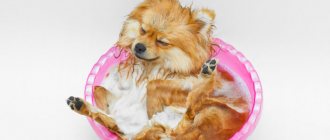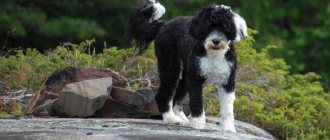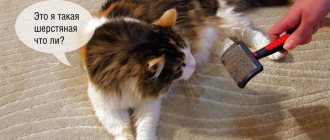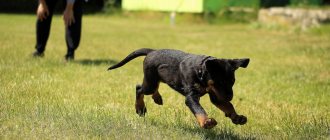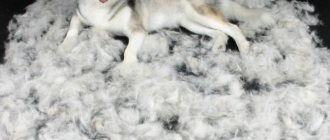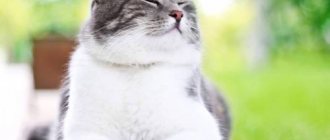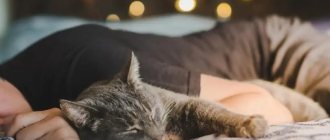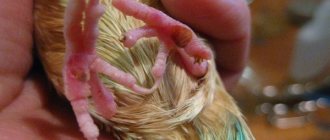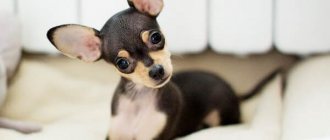What is this
Animal hair is significantly different from the hair that grows on the human body. Of course, each dog breed has its own unique hair characteristics. But they all have one thing in common - the cyclical nature of hair growth and loss. A dog's fur does not grow continuously. After the so-called rest period, the dog begins to rapidly grow hair. After some time, this fur dies and is shed. Moreover, during molting, almost all the hair on the animal’s body is renewed.
After this, the hair begins a new cycle - it begins to grow again. This period lasts on average 130-140 days .
The onset and duration of shedding depends on whether the dog is in its native climate. For example, a husky living in the north never sheds sharply, but changes its hair coat constantly throughout the year. A dog of the same breed living in the central zone sheds its hair like other dogs - twice a year.
Dog fur is divided into three types:
- Tactile is a mustache, eyebrows and short hairs in the ears.
- The guard coat is a hard coat that provides protection from moisture, parasites and serves to camouflage the animal.
- Undercoat - helps maintain proper body temperature, protects from cold and moisture.
Depending on the temperature outside the window, a more intensive renewal of one of them occurs.
Normally, dogs shed in spring and early fall and last one to two weeks. But there are a number of additions to this rule:
- Long-haired dogs (for example, breeds such as Afghan Hound, South Russian Shepherd) need brushing all year round, regardless of the season. Their outer layer of fur changes continuously.
- Bitches begin to shed unexpectedly during the period of estrus. Usually it is shorter lasting, but quite intense.
- Typically, females shed more than males.
- A dog may shed a lot if it suddenly moves to a hot climate.
- In dogs with thick undercoat, the shedding period can last up to 3-3.5 weeks. The fact is that first the dog sheds part of the outer layer, and only then the undercoat sheds.
There are also dogs that don't shed. It is important to purchase such dogs from experienced and trusted breeders, because this property is traceable by pedigree. But you shouldn’t expect that you will never find hair in the house - after all, occasionally, the hair of such dogs falls out. These breeds include: Poodle, Chinese Crested, Miniature Schnauzer, Giant Schnauzer, Fox Terrier, Airedale Terrier, Yorkshire Terrier, White, Scotch, Boston and Staffordshire Terriers, Brussels Griffon, Bichon Frize, Basenji.
Features of shedding by breed
In long-haired
Long-haired dogs are prone to matting. The rich fur coat, consisting of long guard hairs and an impressive undercoat, requires daily brushing during shedding (the result can be a mountain of fluff equal in size to the dog itself).
Moreover, furry pets need to be cut and bathed at least once every 2 weeks. Neglecting this recommendation can lead to matted, unaesthetic tufts that cause irritation on the skin. And parasites, in turn, easily penetrate the wounds. By the way, we have an excellent article about choosing the best drops for fleas and parasites in dogs.
In shorthaired
Smooth-haired dogs shed just as actively as their long-haired relatives, but this process is not as noticeable. But the results of shedding are clearly visible indoors, where short bristles are scattered in large quantities in the corners and baseboards.
The group of short-haired dogs includes many Molossians, Dalmatians, Dobermans, Dachshunds and other owners of needle-haired dogs. Representatives of these breeds are recommended to be brushed with a natural bristle brush, and also wiped twice a day with a terry towel or velor cloth that collects hairs.
In wire-haired
Wire-haired dogs, which include terriers and schnauzers, require specialized help from a groomer. Every six months they need to be taken for trimming (plucking by hand or using hairdressing tools). This requirement is due to the fact that the hard coat itself hardly falls out when shedding, but changing it untimely can cause problems for the dog.
The pet, feeling the need to shed old hair, begins to actively itch, damages the skin and opens the gates for infection.
Breeds that don't shed
Breeds that do not shed hair include, firstly, those that are not endowed with fur: the Xolo, the Chinese Crested Dog and the Peruvian Hairless Dog.
Many people believe that Basenjis and poodles do not shed, but in the first case, short light bristles are simply unnoticeable in the interior, and in the second, the hair gets tangled in curls and does not fall to the floor, although the hair follicles leave the skin and fall off like felt.
By analogy, we can recall the Komondor (a dog with dreadlocks, similar to a giant mop): his long curls, tangled in cords, continue to hang, although most of the hair in them has already fallen out.
Secondly, non-shedding breeds often include dogs whose hair is more reminiscent of long human hair: Afghan hounds and Yorkshire terriers. These sophisticated creatures have virtually no undercoat; their coat consists mainly of awns. Therefore, seasonal shedding is not relevant for them (after all, in the standard case, the dog grows undercoat in the fall and sheds it in the spring).
Important! Even the absence of a hint of vegetation does not guarantee that the owner will not be allergic to the pet. After all, in addition to the fluff itself, any animal has dandruff, which can become a powerful trigger.
Moreover, a person can begin to react to dust particles from dry food, and even to saliva protein or dog sweat, no matter how funny it may sound. And if the dog brings ticks in his symbolic fluff, the sensitive owner will be in doubly bad luck (asthmatics can react especially sharply).
When does seasonality occur and its causes?
When does our wet noses begin to lose hair? A dog's coat is renewed twice a year. This is a natural and natural process, laid down genetically. After all, hair helps a pet adapt to weather conditions and feel comfortable when temperatures change.
When does the spring season start? In spring, the dog loses its thick, long coat – the outer layer. The undercoat becomes much thinner and softer. Spring shedding in dogs usually begins after the end of frost.
In autumn, the light coat of hair is replaced by a coarser one with a thick, dense undercoat - so that the dog does not freeze during cold weather.
How long does it last
The average duration of molting is from 7 to 14 days. It all depends, firstly, on the breed of the pet. The longer and thicker the coat, the longer it will take to change the coat. Secondly, animals that live in an apartment or house all year round cease to react sharply to temperature changes. Therefore, their molting can continue all year, only slightly intensifying in spring and autumn.
The described process refers to natural or planned molting . It is impossible to avoid it or influence its speed, so during such periods it is important to help your pet by brushing it daily.
The condition of a dog's coat is an indicator of its health. Ideally, the coat should be smooth, silky and shiny. If you notice that every day your hair becomes duller, hair constantly falls out, bald spots appear or looks sloppy, immediately contact a specialist. The sooner you diagnose the cause of the illness, the sooner you can begin treatment.
Why does a dog shed for a long time and heavily?
A pet's appearance is a reflection of its health status. Therefore, any abnormal or extraordinary shedding becomes a serious cause for concern and a visit to the veterinarian. The cause of the problem is:
- hormonal disbalance;
- the presence of skin or intestinal parasites;
- infectious diseases;
- skin diseases;
- disturbances in the gastrointestinal tract;
- improper feeding;
- food allergies.
Only a veterinarian can help find out the cause and save the four-legged from inconvenience. Examination of the patient, taking the necessary tests, and a detailed conversation with the owner will allow you to prescribe optimal treatment or give recommendations.
Sometimes seasonal molting is delayed due to living in an apartment with intense heating. In this case, you should walk your dog more often and for longer, and also ask the veterinarian to prescribe good dietary supplements and vitamins.
Why does hair fall out in winter?
If any problems happen to the dog, the owner does not notice alarming symptoms until hair loss begins. What is hidden behind molting in winter and what to do?
Unfortunately, unscheduled winter shedding is a problem that most dog lovers face. If you notice that the animal is shedding, carefully analyze the previous month - were there any alarming symptoms? Maybe the dog was itching more than usual or was very lethargic and inactive.
Tip : A good way to stop shedding is to let your dog bathe in clean snow.
Reasons for early shedding in winter (for example, in February):
- Then carefully examine your pet's skin. If there is redness, you are probably dealing with dermatitis . It is easy to cure, but this should only be done under the supervision of a specialist.
- Often, your dog may react to shampoos or other detergents. Do you wash your dog more often than usual in winter?
- A lack of vitamins A and E, as well as fatty amino acids Omega-3 and Omega-6, significantly worsens the condition of dogs' hair, especially in winter and during the off-season. Be sure to take vitamin courses if you feed your dog dry food.
- Impaired body functions may be a reaction to the environment. An animal may react negatively to the reagent or salt that is sprinkled on sidewalks. Carefully examine your pet's paws - are there any wounds or ulcers on them? An unpleasant odor will also be a bad symptom.
- The cause may also be infection by parasites . Fleas or lice can appear on an animal even in winter. Inspect the fur, especially the ears, belly, and inner thighs. Look not only for the insects themselves, but also for traces of their vital activity - red dots from bites and larvae.
IMPORTANT: If you find a lice eater, be sure to take an additional anthelmintic. After all, lice eaters can carry worms.
Pathological cases requiring treatment by a veterinarian
If a pet falls ill, an attentive owner will definitely note uncharacteristic details of his condition.
Here is a list of symptoms that require urgent medical attention:
- apathy,
- refusal of food,
- diarrhea and vomiting,
- temperature increase,
- skin problems,
- itching,
- unnatural smell.
In these cases, hair loss is only a consequence of problems with well-being, and you cannot delay a visit to the doctor.
Hormonal disbalance
Most often, hormonal imbalance refers to hypothyroidism (insufficient functioning of the thyroid gland). In this case, the dog will go bald gradually, but over a large area and symmetrically. The matter is not limited to baldness; this problem is usually accompanied by bradycardia and the appearance of age spots. Treatment consists of taking synthetic medications intended for the thyroid gland.
With an excess of cortisol, a large amount of hair loss also occurs, while the dog experiences extreme thirst, urinates frequently and quickly loses weight. Treatment is aimed at suppressing cortisol production.
Hyper- and hypoestrogenism are associated with an excess or deficiency of estrogen. In the first case, both sexes can be affected by the disease, and the issue is resolved by surgery. In the second case, middle-aged ladies usually suffer, and therapy consists of taking hormonal pills.
Parasite infestation
When a pet is attacked by parasites, it is difficult to make a mistake: fleas often bite the owner himself, and they themselves and traces of their vital activity are visible to the naked eye. In this case, the dog itches furiously and gnaws its fur, its skin becomes covered with small ulcers. With demodicosis, the pet may become almost completely bald, and the skin will be noticeably sore. Fortunately, there are dozens of topical medications against blood-sucking insects.
Food allergies
It happens that ready-made food or several components in a natural diet are not suitable for a dog. The consequence will be that the dog will begin to constantly itch and tear out its fur. In addition to minor wounds, you can pay attention to rashes and conjunctivitis. The doctor will most likely prescribe a food review, as well as antihistamines and antibiotics.
Yeast or bacterial infection
With trichophytosis, microsporia and ringworm, hair loss and peeling of the skin, inflammation, and the presence of purulent wounds are observed. Pyoderma and abscesses look similar, with the skin looking like sandpaper and developing ulcers. In both cases, antibiotics and medications are prescribed to relieve symptoms.
Lack of micro- and macroelements
Hypovitaminosis is not as dangerous as hypervitaminosis (the consequences of which can be treated for several months, so you need to be careful about the dosage). But this condition is also characterized by a number of problems: partial baldness, itching, lightening of the mucous membrane and low temperature. This is basically how vitamin A and B vitamin deficiency manifests itself.
When does the first one start?
At what age does hair loss first occur? Age-related shedding is a natural process that all dogs undergo at a certain age. The first shedding occurs at about two months (or less) - when puppy fluff is replaced by the first coat. This coat is usually a different color from that of a puppy. It can be a couple of shades darker or lighter. Teenage fur already resembles the fur of an adult animal in structure and properties.
The next molt occurs at approximately six months . From this point on, the dog's hair will gradually change, forming a denser and thicker layer. In some breeds of dogs (long-haired with a thick, dense coat), several molts must occur to completely get rid of teenage hair.
Cases when you should contact a veterinarian during shedding
The change of coat occurs differently in animals depending on their character and temperament. If the process occurs for the first time, and the owner does not know how to react to the difficulties that arise, you should be aware of a number of symptoms, and if they appear, you should immediately consult a doctor:
- the dog is nervous, anxious or clinging to the owner;
- attempts to caress cause aggression and a painful reaction;
- refusal to eat;
- vomiting and bowel dysfunction;
- apathy;
- bald patches and skin rashes;
- unpleasant odor from wool;
- accumulation of mucus in the corners of the eyes;
- elevated temperature.
Each of the manifestations is a sign of the disease; if there are two or more, they urgently go to the clinic and conduct a full examination, including examination and taking samples.
How to fight: express (artificial)
A so-called “express shedding” service for dogs is currently available. It is offered in almost every pet salon, although some owners carry out this procedure on their own at home.
Express shedding at home for dogs - how is it done? How to speed up shedding?
It consists of washing with a special product in very warm water. Then the mask is applied. The animal is covered with a film and a towel on top. This creates a sauna effect. Thanks to this, the pores open and all the hair ready for shedding is removed much faster.
The mask is washed off, and the coat is thoroughly combed, exposing the coat to hot air using a hairdryer. Express shedding removes almost 90% of shed hair.
IMPORTANT: This procedure is absolutely safe for the animal. But this service is not suitable for dogs that are not accustomed to bathing, brushing and blow-drying.
Tools for combing wool
To carefully comb out loose hair and painlessly remove formed tangles, there are various devices:
- comb made of hardened steel, the best option is nickel plated. This tool is most often used for grooming the undercoat;
- slicker This brush is suitable for sensitive dogs who cannot tolerate a metal comb. She carefully and delicately combs out the accumulated hair;
- A glove brush is used to comb out and collect dead hairs. It fits comfortably on your hand and effectively removes hair;
- The furminator is a modern tool that can replace all of the above devices. The Furminator is similar to a comb, but has a steel blade with teeth and a comfortable rubber handle. Thanks to the slotted blade, the undercoat is easily removed from the coat without damaging living hairs.
Important: you cannot use the furminator if there are irritations, sores, wounds or similar damage on the animal’s skin. Also, the use of the device is not allowed if the dog has mats. In this case, they must be carefully removed in advance so that the furminator does not cause pain to the animal.
Regular brushing of your dog will prevent hair from settling on the furniture and floor. The most convenient way to deal with hair is to place your pet on newspaper or cellophane. This will help you remove lost hair very quickly.
What to do if it is very strong?
The situation is completely different when unscheduled, prolonged or very intense molting begins. This may be a signal of either age-related changes or disruptions in the functioning of the animal’s body.
If you notice that your pet is shedding more or for longer than usual, the first step is to contact your veterinarian. It is better to immediately conduct an examination and, if necessary, get tested.
The most common causes of severe hair loss:
- Insufficient or unbalanced nutrition.
- Lack of vitamins and microelements.
- Dehydration.
- Immune disorders.
- Infestation with parasites.
- Hormonal imbalances.
- Diseases of the gastrointestinal tract, kidneys, liver.
- Endocrine disorders.
- Hepatitis.
- Severe stress (for example, due to moving or separation from the owner for a long time).
- Too frequent bathing using shampoos and other detergents.
- Allergies (to food, shampoos, environmental items, etc.).
To help your pet during periods of intense shedding, you need to brush it daily . This is easy to do with the help of various combs and brushes sold in pet stores. Select a brush that suits your coat type and carry out this procedure at least once a day.
This will not only get rid of hair on the floor and furniture, but will also significantly speed up the shedding process. The coat will renew itself faster and become silkier, because with the brush you are working on the dog’s skin layer, increasing the blood supply to the hair follicles.
IMPORTANT: Short-haired dogs, in addition to combing, must be wiped with a special terry towel. It should be tough to help the dog get rid of excess hair that the brush could not remove.
How can the owner help the dog?
The owner can help the pet survive the molting painlessly, so that the animal does not scratch all its skin and does not remain in tangles.
If your pet doesn’t have suspicious rashes, scabs or visible damage, he doesn’t comb the same places and there are no visible bald spots, all you have to do is wait until the dog gets a new head of hair that will be the envy of everyone.
And, of course, the owner must understand whether the dog sheds more often and longer than expected.
In certain cases, constant, rather than seasonal, shedding can signal possible ill health. You need to evaluate whether a lot of hair is being shed, and if it is shedding in minimal amounts, then there is nothing to worry about.
But if in doubt, you can contact your veterinarian to rule out the following conditions:
- allergic skin rashes;
- presence of parasites;
- hormonal disbalance;
- stress;
- yeast dermatitis or bacterial disease;
- incorrect temperature conditions (when the room is more than 25 degrees, this is harmful not only for the beauty of the fur, but also for the heart).
In addition to the reasons listed, it is easy to assume pregnancy in females, during and after which increased hair loss is also likely.
Neutered shorthaired females, on the other hand, often shed year-round, but little by little.
Also, the answer may lie in insufficient or inappropriate nutrition: this condition is often the result of a food allergy, when the dog furiously scratches the skin and rips fur out of it.
For an owner who wants to understand the unnaturally long and intense shedding of a pet, the veterinarian may recommend an examination with a visual examination, trichoscopy, cytological examination, scraping and blood tests.
What tools and combs are needed
- Using combs with moving teeth and slicker brushes, the owner collects loose hairs before they fall to the floor. You need to comb in the direction of hair growth (towards the ends), but without pressing or scratching the skin. The fur should be dry and clean, and there should be no damage to the skin.
Important! Grooming tools in inept hands can scratch the animal, and no one will like the process of tearing out tufts. Therefore, the animal may be dissatisfied with the daily use of a slicker brush and a sharp comb.
- When using a furminator, the owner does not scratch the pet or tear out healthy fur. According to groomers, this tool reduces shedding by more than half. But there are also disadvantages: it is not cheap and cannot be used on damaged skin.
- Fine and short hair requires frequent combing with closely spaced teeth. This device removes dirt and parasites well.
- For short-haired dogs, soft brushes made of natural bristles and terry towels are recommended to remove loose hairs. You can also use massage mittens.
- In advanced cases, a tangle cutter may be useful: vertical, horizontal and drop-shaped.
- An alternative to a mat cutter is a clipper.
- The trimming knife is suitable for terriers and schnauzers. This device catches old bristles and painlessly removes them from the hard coat.
How to brush a dog: frequency of brushing
Dead hairs are removed with brushes and slickers. If there are damaged areas on the skin, it is better to do without brushes. The tool should be guided from roots to ends, pressing the hair towards the body without force.
Trying not to damage the skin, you need to brush with a leisurely movement and repeat this procedure 1-2 times a day.
Nutrition and vitamins
- B vitamins are a traditional recommendation. It cannot be said that they stimulate shedding, but they certainly have a beneficial effect on the condition of the renewed coat.
- It is often recommended to take brewer's yeast (preferably in the form of ready-made supplements).
- Fish oil also improves the condition of the hair.
It is important not to exceed the dosage, especially in the case of vitamins, since B-hypervitaminosis can lead to allergies. Only skin problems during the period of prolonged molting were not enough!
Proper and expensive food that ensures rapid coat change must contain a sufficient amount of protein, which gives strength and shine to the hair. During shedding, it is also recommended to give your pet raw offal. We also recommend reading about Holistic food for dogs.
Is bathing necessary?
- By purchasing special shampoos to renew the coat, you can notice improvements in the quality of the hair: it becomes more shiny, and the amount of dandruff decreases. But the main purpose of such a shampoo is to stimulate hair change: thanks to them, the old hair falls out even faster.
- Some groomers recommend using anti-shedding sprays that strengthen hair. These cosmetics act opposite to shampoos, maximizing fur improvement and preventing hair loss.
As for the need for water treatments, you need to look at the breed of your pet, since for some of them monthly bathing is contraindicated.
How to speed up and reduce?
It is impossible to completely stop the process of hair loss. But you can speed it up. This will help your pet recover as quickly as possible.
- An essential condition is daily combing of the coat.
- To speed up hair renewal, washing your dog in warm water using protein shampoo or a special product for animals during the molting period will help. After washing your pet, you need to wrap it in a towel for 1-2 hours. It is important to carefully monitor its condition to prevent overheating. Then the animal must be thoroughly combed. This will speed up the molting process, but you should not resort to this method too often.
- If you want to improve the condition of the coat, it is important your pet properly During this period, the dog spends a lot of energy on the formation of new hair. A complex of vitamins and a balanced diet will help the animal maintain health.
- You can add vegetable oils or fish oil at the rate of 1 teaspoon per 4.5 kg of body weight. Once a week you can give fillets of sea fish.
Mud fight: how often and with what can you wash your dog?
Prevention of excessive hair loss in dogs
In order for hair loss to be natural and physiological, limited to seasonal changes, you need to remove allergens from food, select vitamins and high-quality food, treat the dog with anti-parasite drugs, comb it regularly, and use a suitable shampoo when bathing.
Any symptoms associated with hair loss should be noted and shown to a veterinarian because they may only be the visible part of the iceberg and signal a health problem.
Remedies and tablets from: what vitamins to give during?
Pharmaceutical companies offer a wide selection of vitamin and mineral complexes that help your pet quickly restore health and get rid of unplanned shedding.
It is important to understand what vitamins are necessary for skin and coat:
- Vitamin A is the main anti-shedding vitamin and is essential in the synthesis of collagen, elastane and keratin fibers. If there is not enough of it, the coat becomes dull and brittle. Vitamin A (or retinol) is an essential component of any complex for dog hair.
- Vitamin E - helps cope with the negative effects of the environment. It is also called "tocopherol". Tocopherol significantly reduces the amount of hair falling out.
- Vitamin C – helps improve blood circulation and nutrition of hair follicles. With a lack of this vitamin, the animal's hair becomes dry and brittle.
- B vitamins are indispensable in the treatment of skin diseases and malfunction of the sebaceous glands. It is important to use these vitamins not only during illness, but also for prevention.
- Vitamin PP or nicotinic acid has a beneficial effect on the level of pigmentation. The pet's coat will be bright and shiny.
- Fatty acids have already been mentioned above. Omega-3 and 6 help quickly renew hair. The wool becomes soft, elastic and shiny. With regular use of Omega, coat density approaches the optimal values for the breed.
- Zinc supports proper functioning of the thyroid gland.
- Sulfur not only helps to cope with seborrhea and hyperkeratosis, but also improves the functioning of the sebaceous glands.
- The combination of phosphorus and calcium is necessary to maintain the natural shine of the coat.
- Manganese is necessary for the synthesis of keratin.
- Copper allows collagen to form, which makes the coat soft and free from breakage.
Vitamin complexes and tablets offered by pharmaceutical companies include Yumega Boost, Virbac Megaderm, VitsCan and Safari Skin and Coat.
IMPORTANT: Before giving your pet medications or any vitamin complexes, consult your veterinarian.
Solving the problem of out-of-season shedding
Having found out the reasons for the unusual condition of your pet, do not forget about regular combing of the fur; you should resort to this procedure both in summer and winter. Brushes made of natural bristles - pork or horse bristles - are best suited for this purpose. A pet with a long and thick coat should be combed once a week, carefully unraveling tangles and removing dead hairs. Smooth-haired animals need grooming a little less often; a medium-hard brush is suitable for them.
Decorative breeds of dogs, for example, Yorkshire terriers, need periodic haircuts with special scissors. Experienced breeders use special clippers for this purpose, which allow you to create a short, hygienic hairstyle in the summer and maintain the beauty of the coat all year round.
Changing food is also a solution to the problem faced by owners of furry pets. A dog sheds all year round if it does not receive all the necessary substances to maintain health. What to do in this case? Properly selected dry food contains essential vitamins and fatty acids, as well as valuable microelements. Often, correcting the diet allows you to get rid of troubles, especially if your pet has recently lost weight.
Hygiene plays a significant role in maintaining the beauty and health of a dog’s coat. It is not enough to simply clean the fur from dirt and dust in bad weather; the pet needs a bath.
What should the owner do? An animal that is constantly outdoors in the private sector in the summer is rarely washed. However, dogs that spend maximum time in the fresh air are practically not susceptible to slow hair loss, the reasons for this lie in regular physical activity and adaptation to environmental conditions.
A domestic dog sheds in summer and winter, and its owner is trying to figure out why this happens. Whatever the reasons for hair loss, the dog must be accustomed to water procedures from an early age.
To keep your pet healthy all year round, it is washed with a special shampoo that repels fleas and ticks. It is especially important to take care of your dog’s safety in spring and summer, when the risk of parasites increases.
But it is not recommended to bathe small lap dogs often, since their skin is prone to drying out, sometimes the dog resists water treatments and bites, why does the pet behave this way? The appearance of peeling and irritation leads to the fact that the ornamental animal begins to itch, thereby provoking hair loss. Such shedding can last a long time and harm the dog’s health.
First of all, you should consult a veterinarian to eliminate bald spots and redness, and also introduce healthy supplements into the diet that will improve the quality of the skin and coat.
Prevention
How to protect your beloved pet from unscheduled shedding? This question is often asked by dog owners. After all, you want your four-legged friend to always be cheerful and healthy. For this, constant care and attention is important.
- Routine visit to the veterinarian.
Often, only an experienced specialist can replace the disease in the early stages, which will allow your pet to be quickly cured.
- Systematic inspection of the animal's home.
It is important to check whether the animal has parasites and whether the condition of its skin, fur, teeth and gums is normal.
- Taking vitamins and proper nutrition.
Make sure that your pet eats regularly and only fresh food intended for its age and breed.
- Regular washing and combing of wool.
Still, you should not bathe your dog too often, but it is also undesirable to neglect hygiene.
- Peace.
Any stress causes irreparable damage to the animal’s psyche. Try to avoid this.
- Walks in the open air.
Walk your dog every day, even in bad weather. But be careful - do not allow the animal to overheat or hypothermia.
So, it is very important to monitor the condition of your pet and help him not only during periods of stress, but also to provide proper prevention. A dog is not only a source of joy, but also a great responsibility.
Caring for a dog during shedding
To ensure your pet survives this period comfortably, follow the care recommendations.
Brush your dog's fur daily with a specially selected brush, undercoat furminator or massage comb. Such manipulations are useful for the animal because they help remove dead hair and accelerate the growth of new ones; stimulate the upper layer of the epidermis, which improves blood supply and supply of nutrients to the hair roots; improves the appearance of the pet, because the fur becomes smooth and silky. In addition, daily grooming of your dog will reduce the need to constantly vacuum and clean, and reduce the amount of hair in the house.
Use a special conditioner for dogs that improves the texture of the coat and nourishes the skin. The product allows you to make hair flexible, they will not get tangled during combing.
It is not recommended to bathe your dog frequently, but when it is really necessary, use a pet shampoo that contains protein and strengthens the coat. Use a cleanser to nourish your hair follicles no more than once a month.
Add cold-pressed oils, minerals and vitamins to your dog's regular diet. It is recommended to use special complex preparations that improve wool quality. If you feed your dog natural food, increase the protein content in the daily menu. Wool consists of keratin, and it is the protein components that are the building material of hair and make it elastic. It is advisable to add complete protein in the form of low-fat meat, liver and chicken hearts. You can give your pet low-fat sea fish, but make sure there are no bones in it. Consuming natural fish oil will also have a beneficial effect on your dog’s health. Also, the diet should be enriched with cereals and vegetables, and if the animal does not like them, canned vegetables can be added to the food.
Photo
Master, comb me!
What are you watching? Clean it up!
Conclusion
- Shedding in dogs is divided into natural and unplanned.
- Natural molting occurs in the off-season, that is, in spring and early autumn.
- Unscheduled shedding can occur for natural reasons (estrus, stress, sudden climate change), or it can be an indicator of serious diseases.
- The dog begins to shed at the age of six months.
- It is important to brush your dog regularly to prevent matting.
- You can help your pet during this difficult period with the help of an express shedding service, proper diet and vitamin intake.
Surely each of you has your own secrets. What do you do during shedding? How do you deal with the amount of wool in the house? How is your dog feeling? Share information and, of course, a photo of your wonderful pet!
Express molt
Professional pet salons offer a special service called “Express shedding.” Its essence is as follows: the masters carefully comb the dog with various tools, and then bathe it using special shampoos and masks to open the pores and remove shedding hair. Further, during drying, the fallen hairs are blown with a powerful hairdryer, while simultaneously combing and styling the coat.
The procedure is suitable for all types of dogs, except hairless ones, and can significantly reduce the amount of hair deposited in the apartment.
